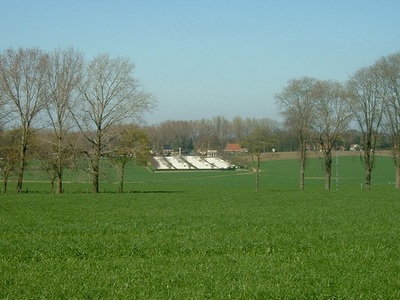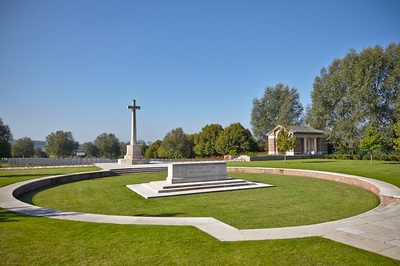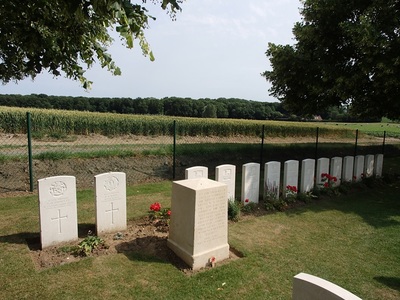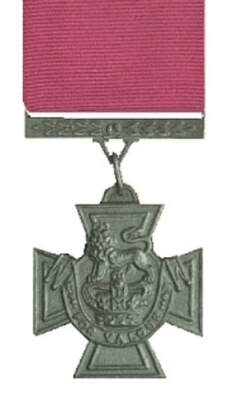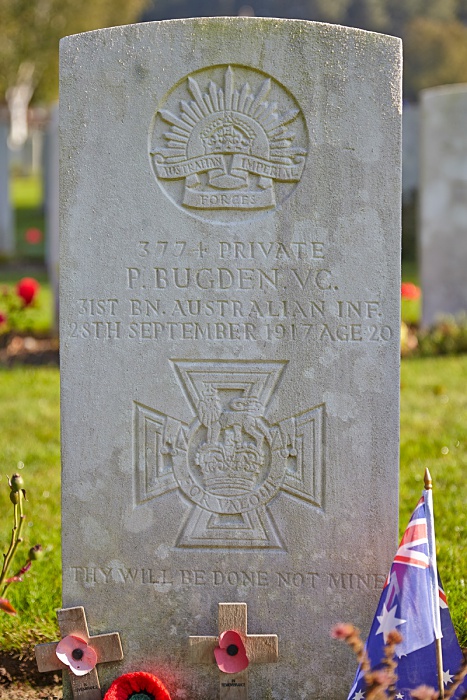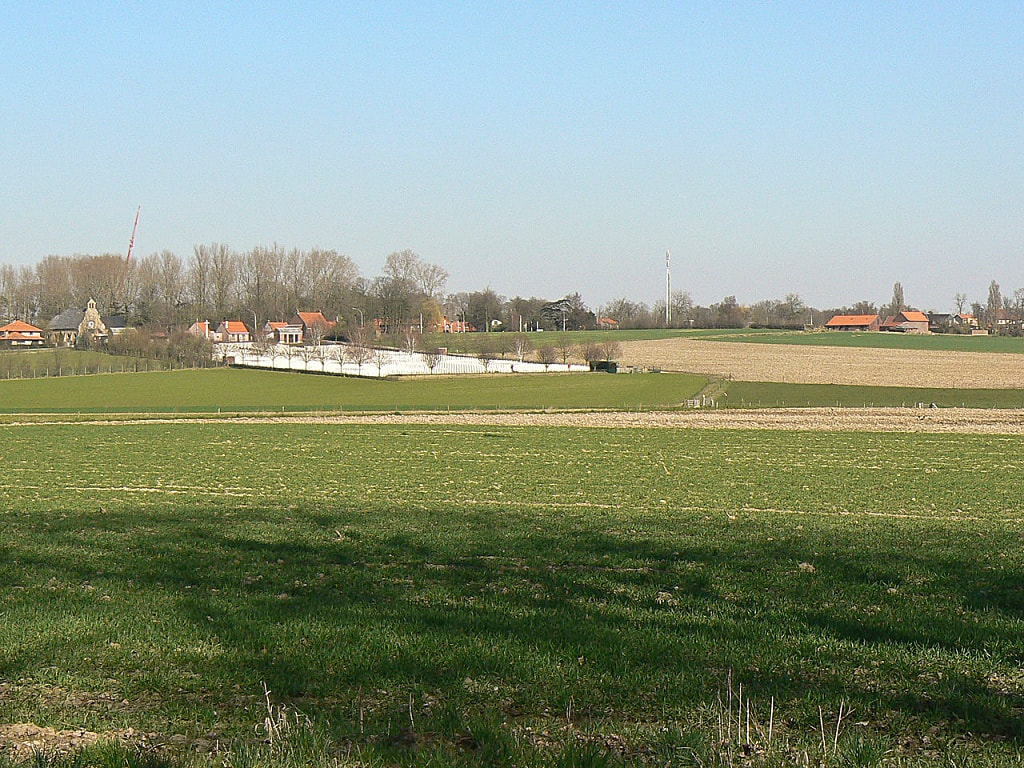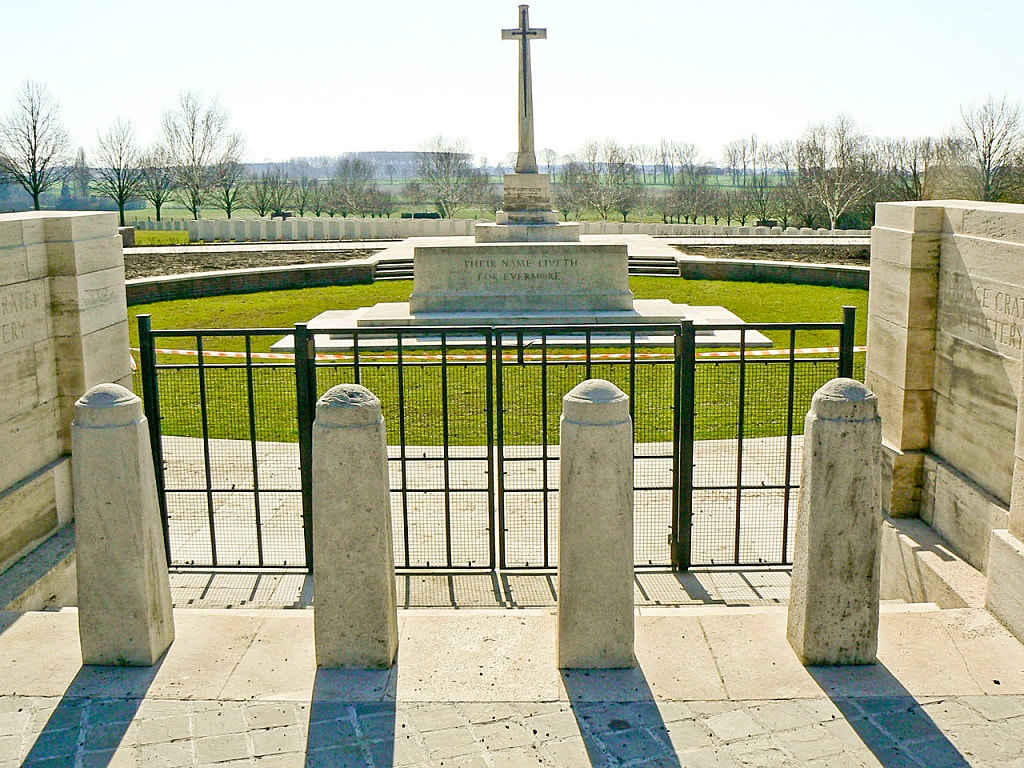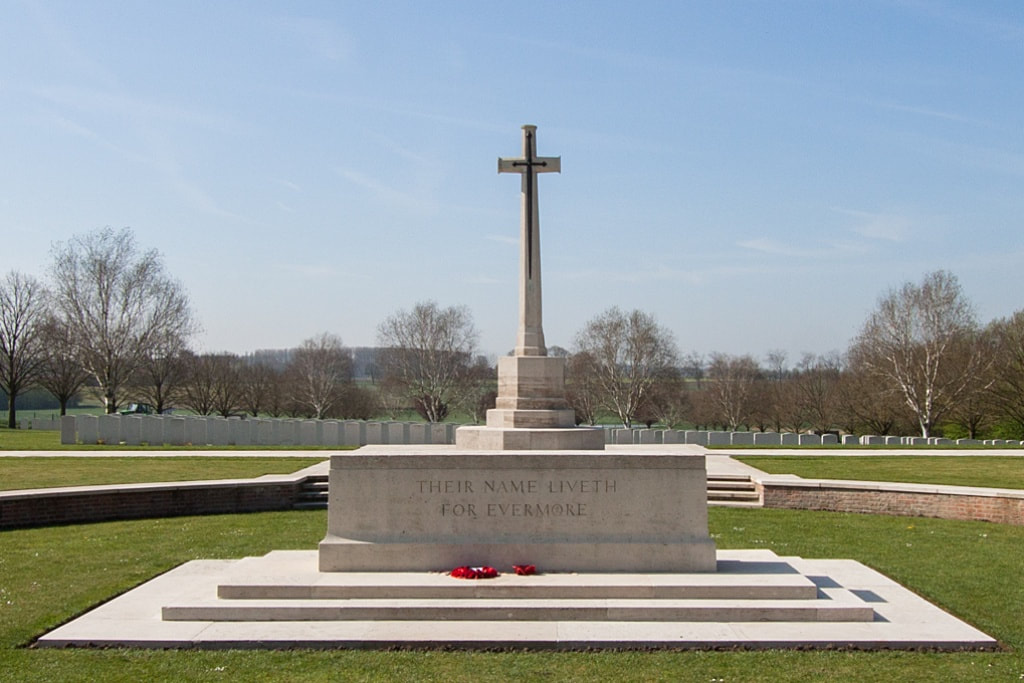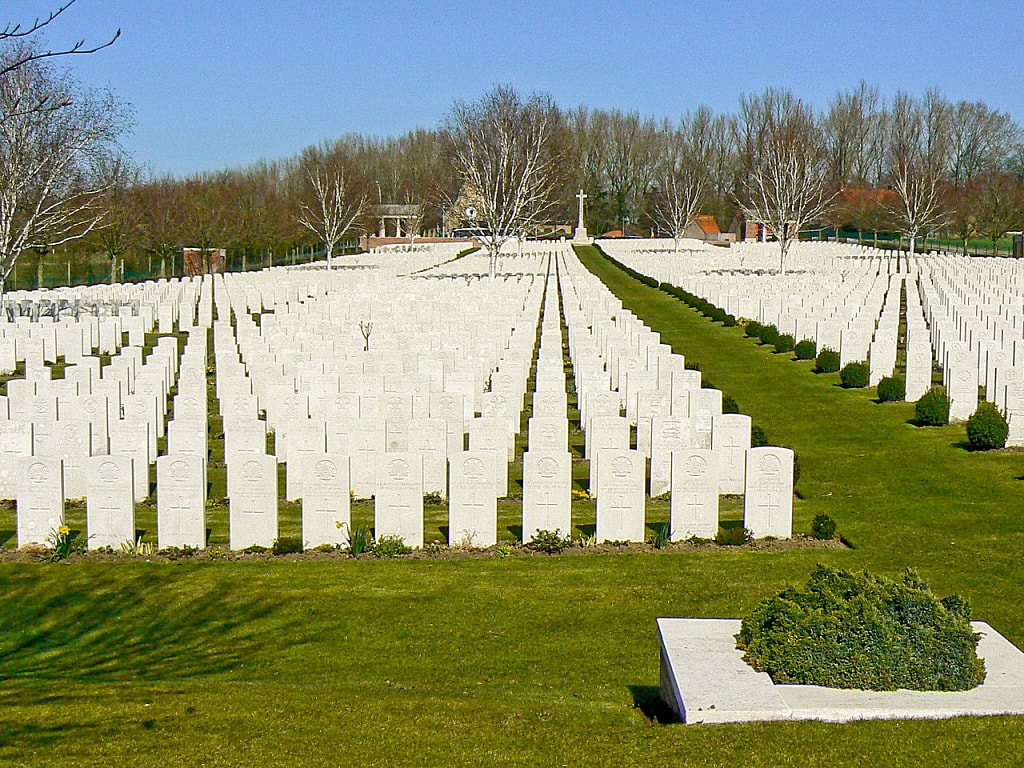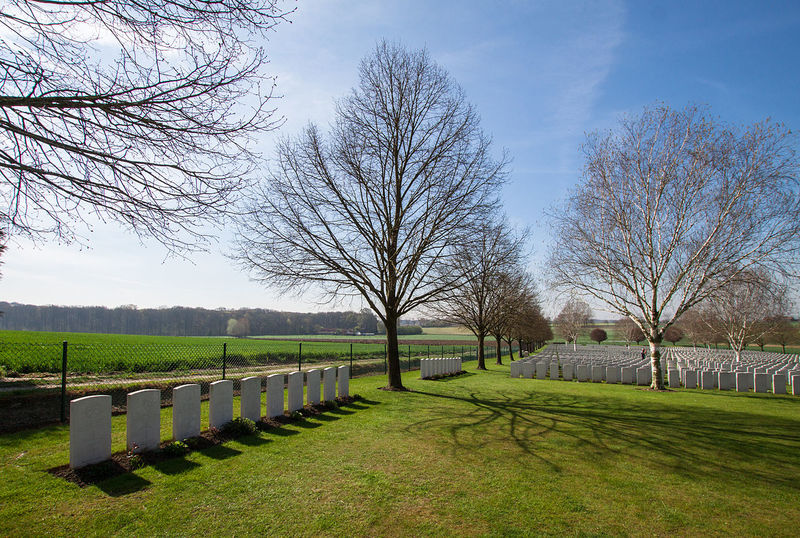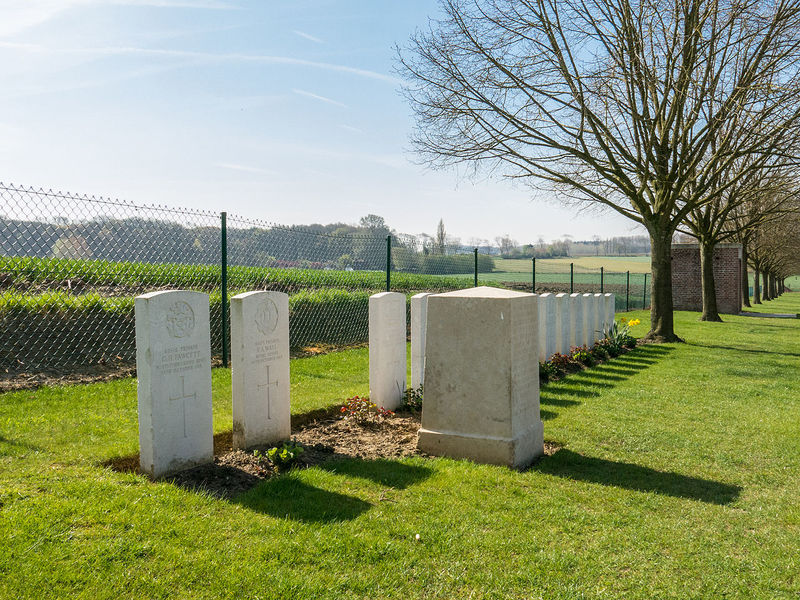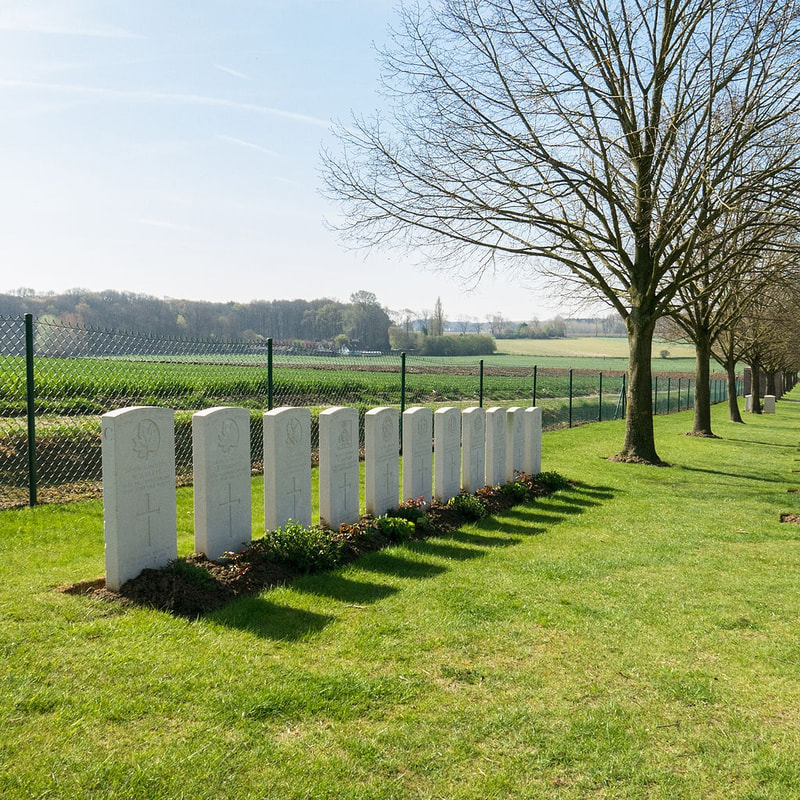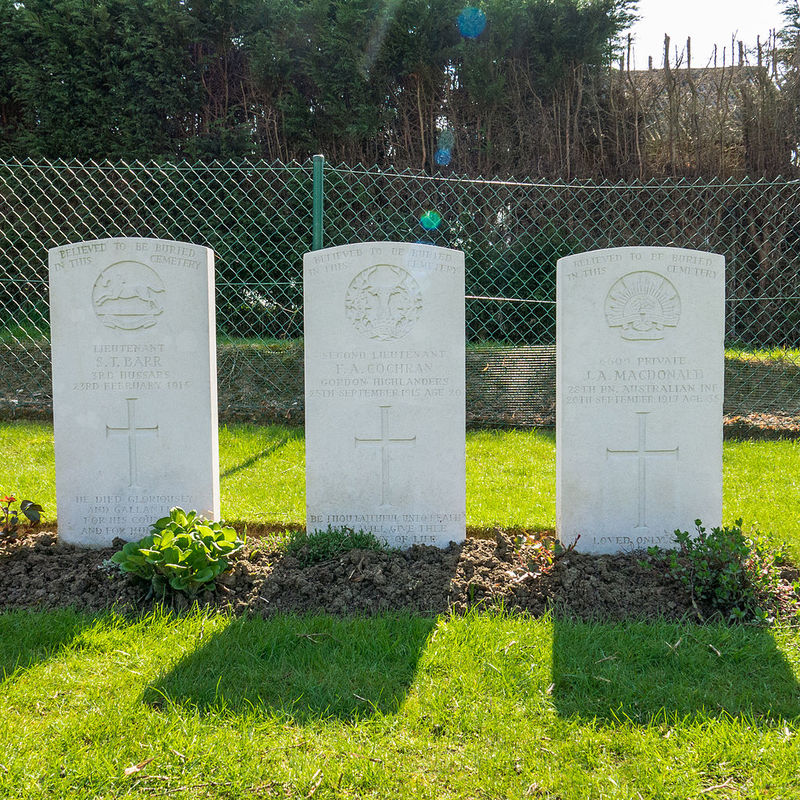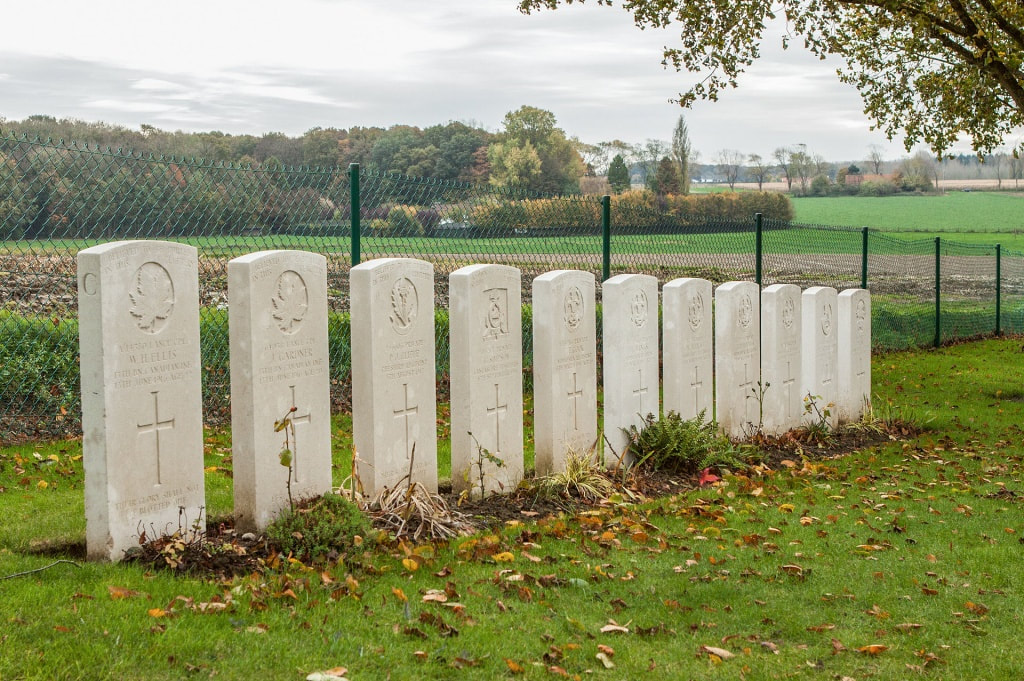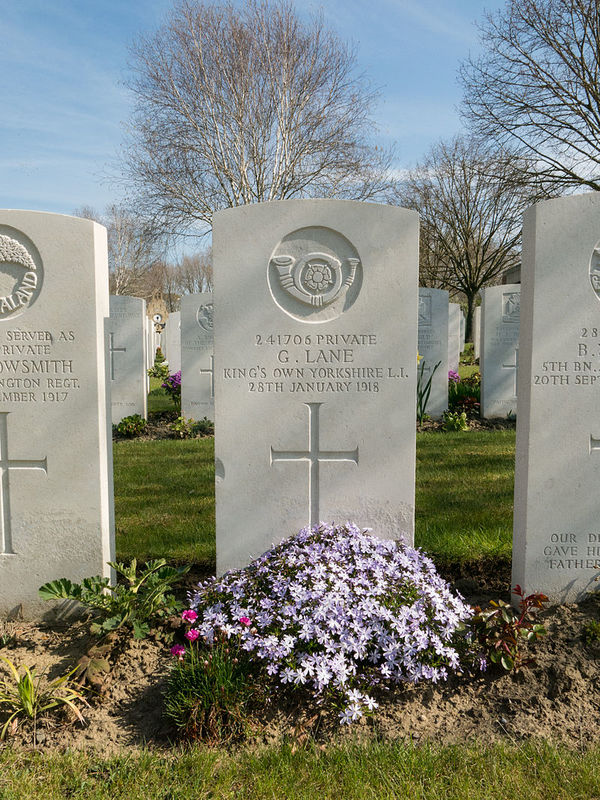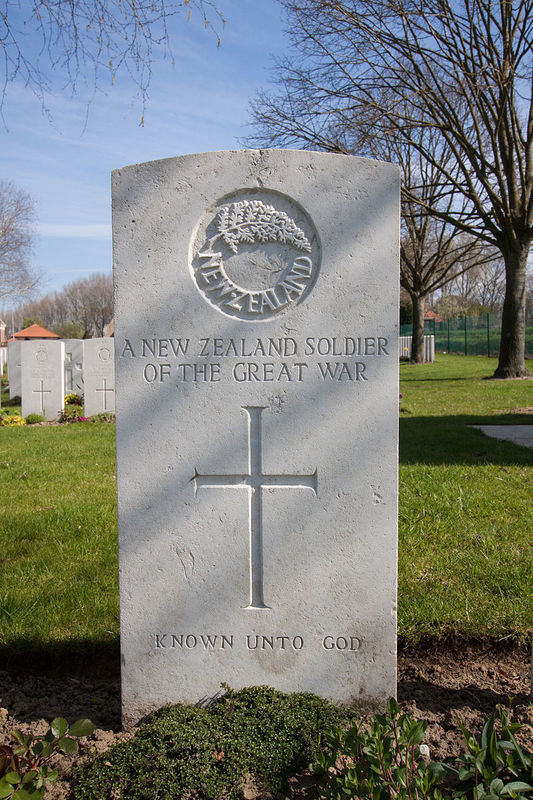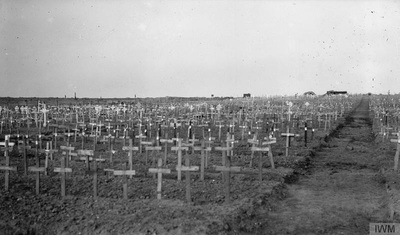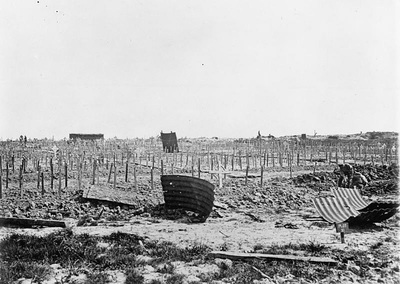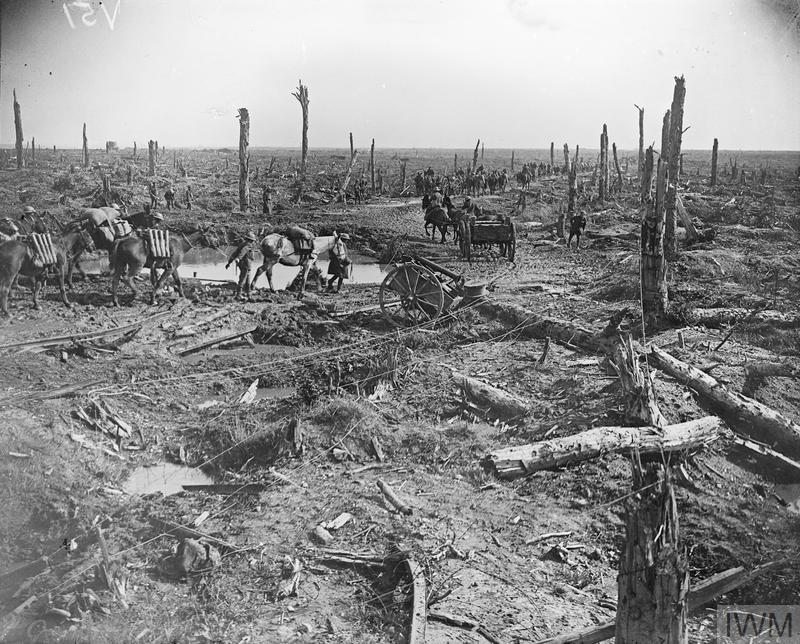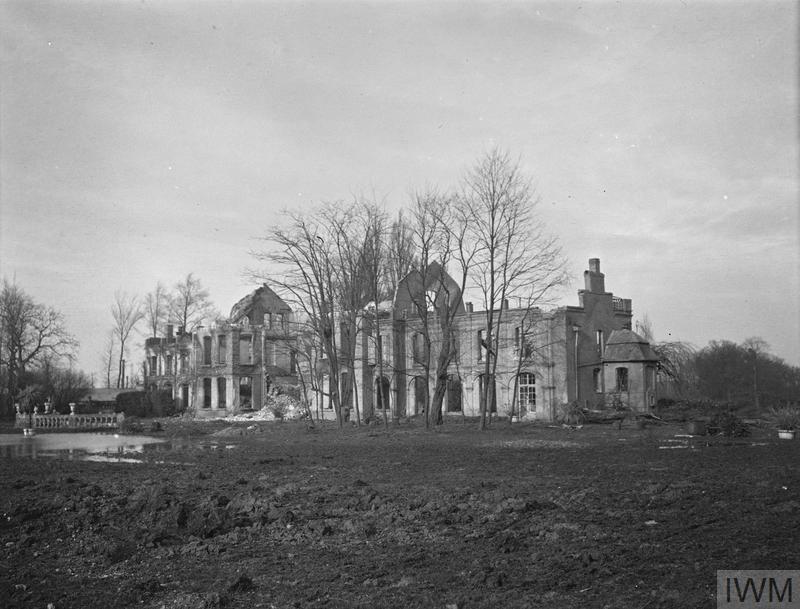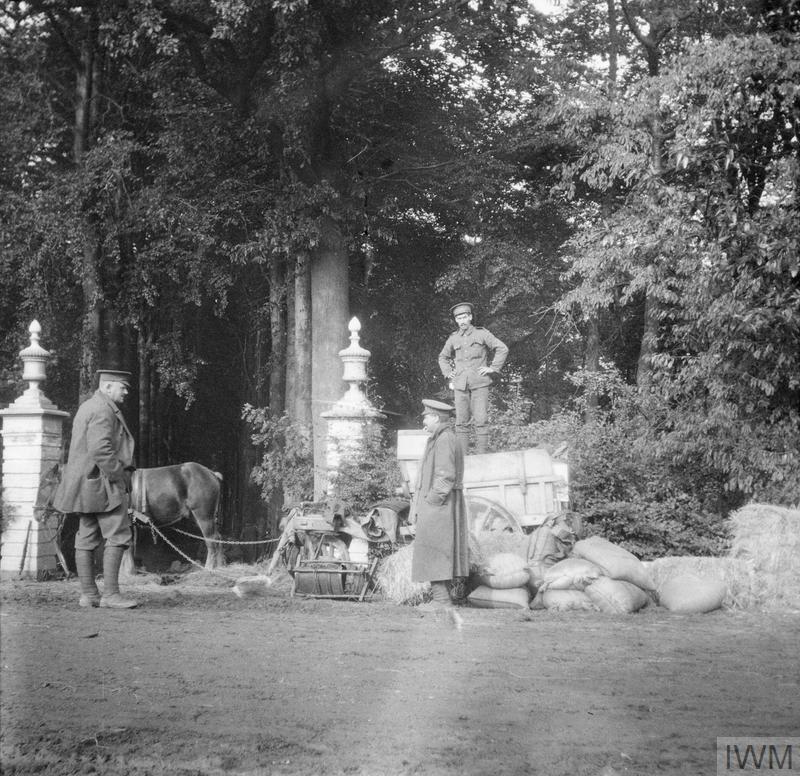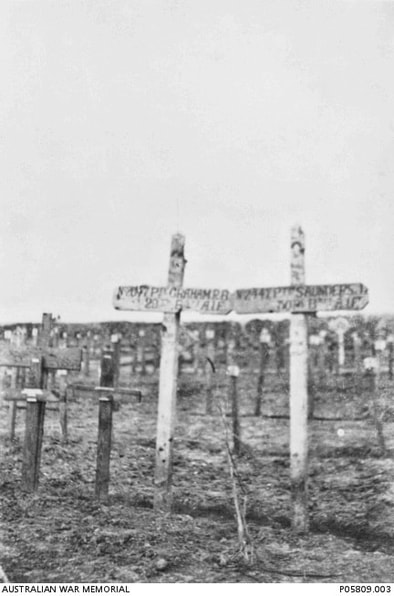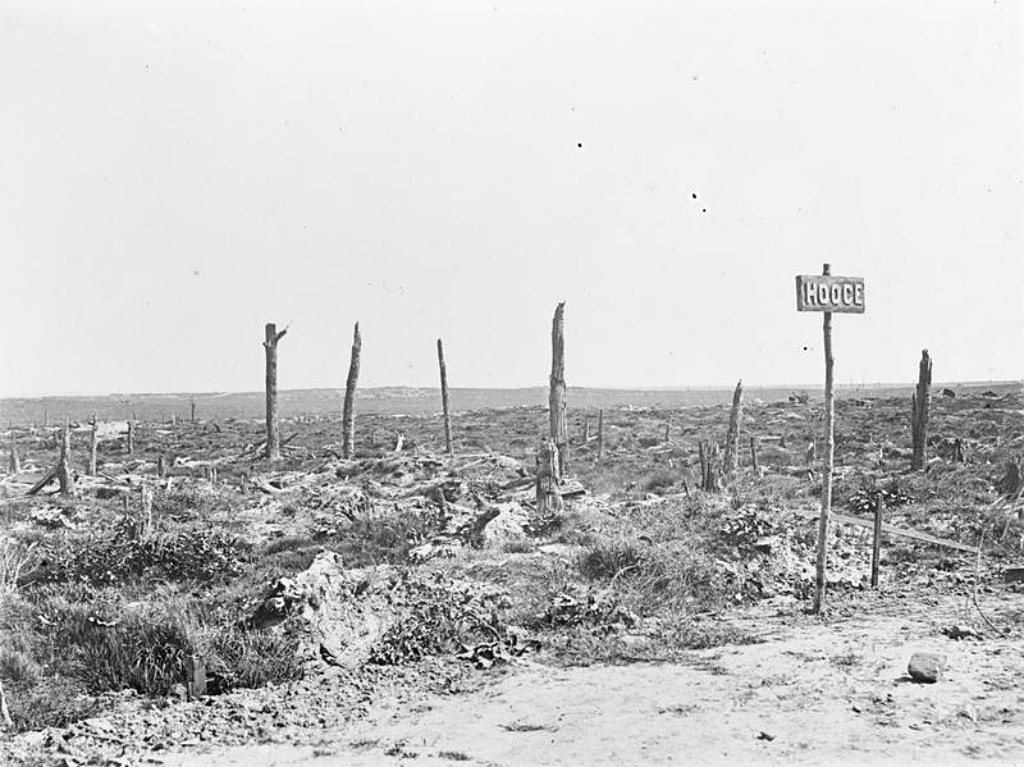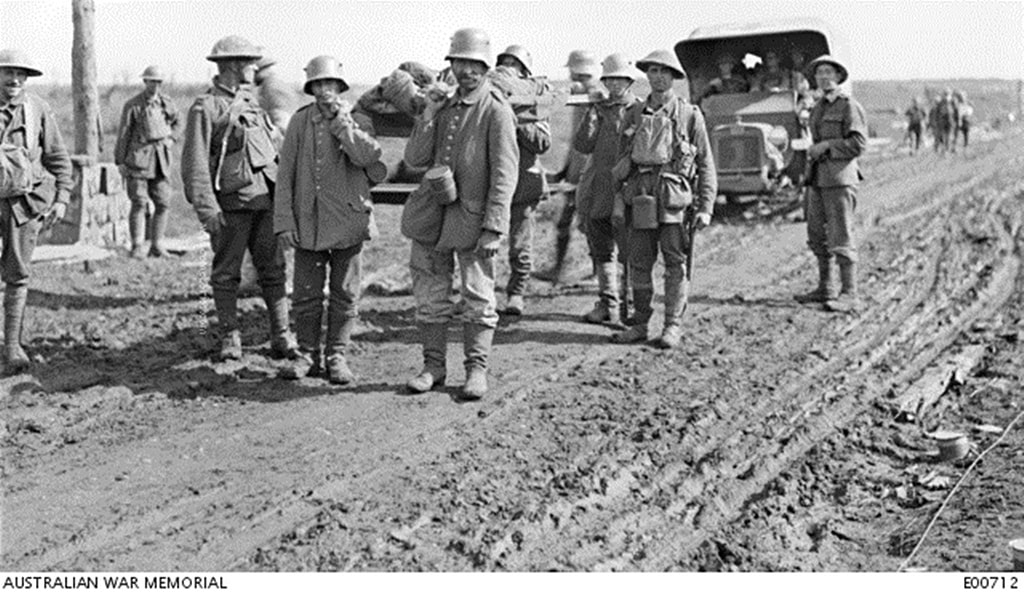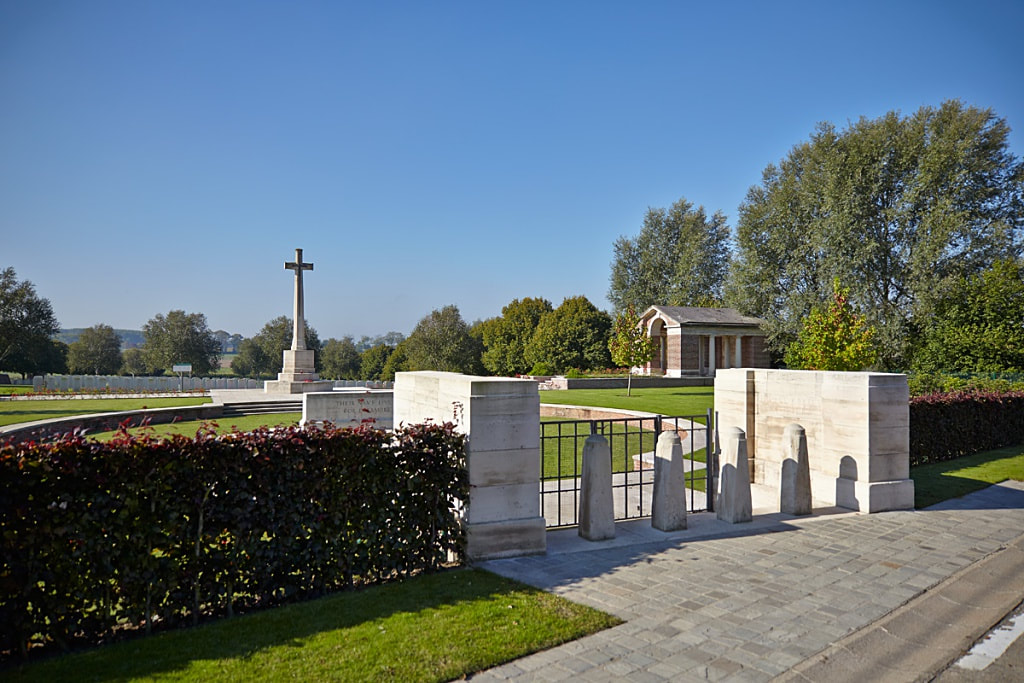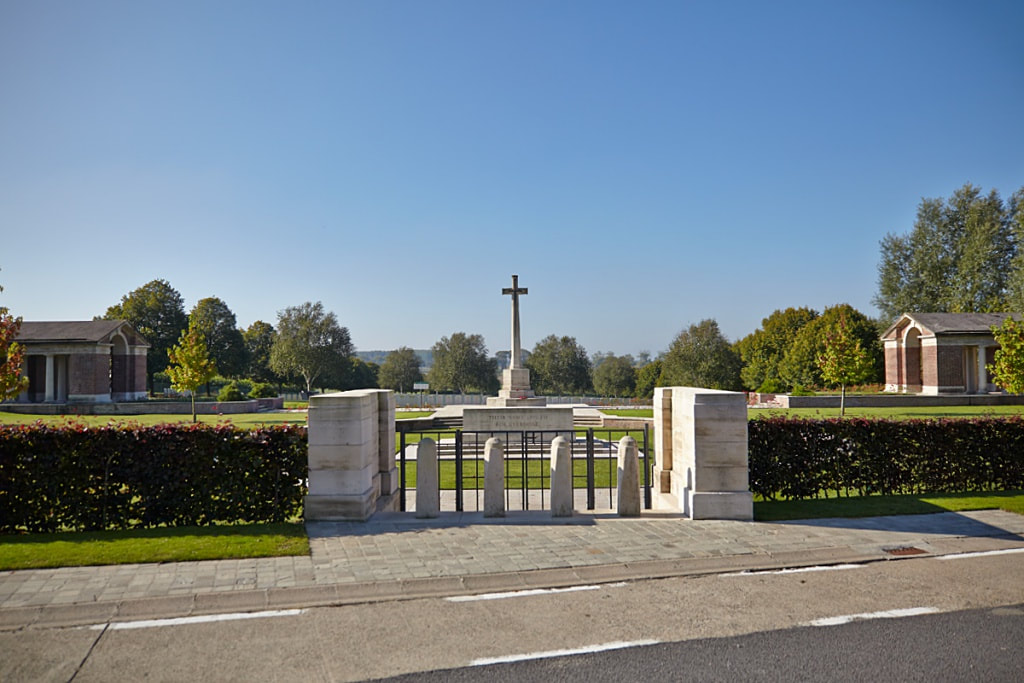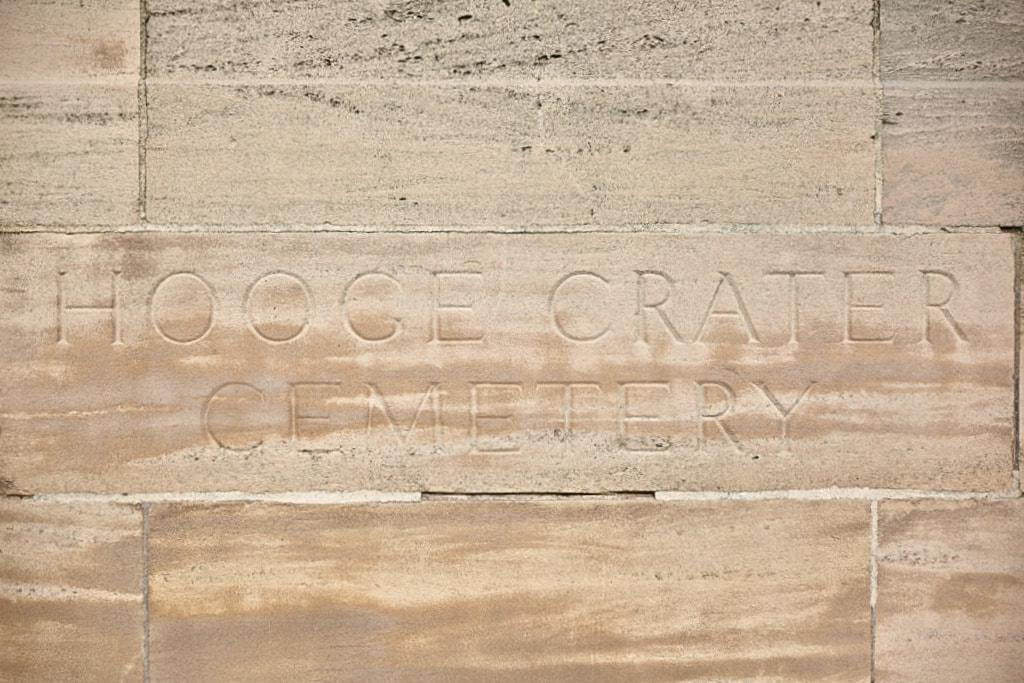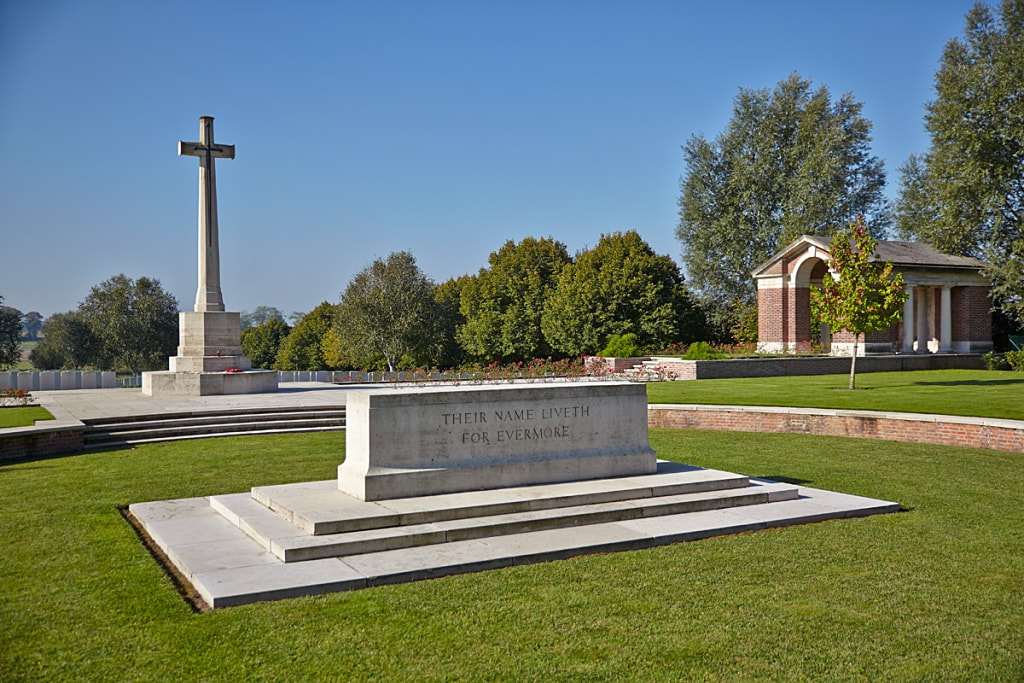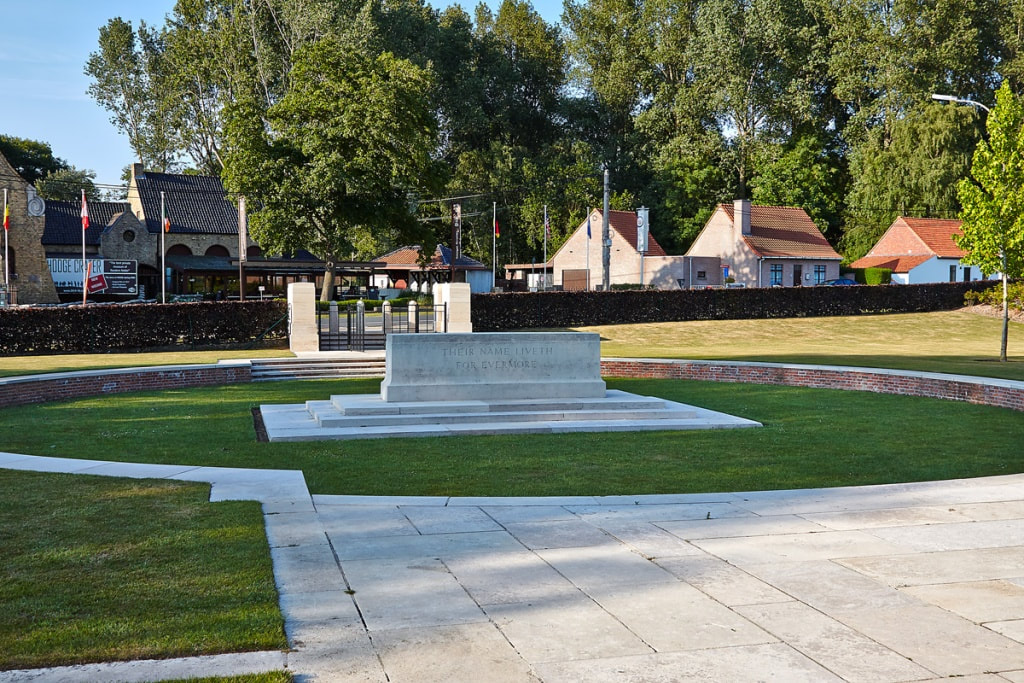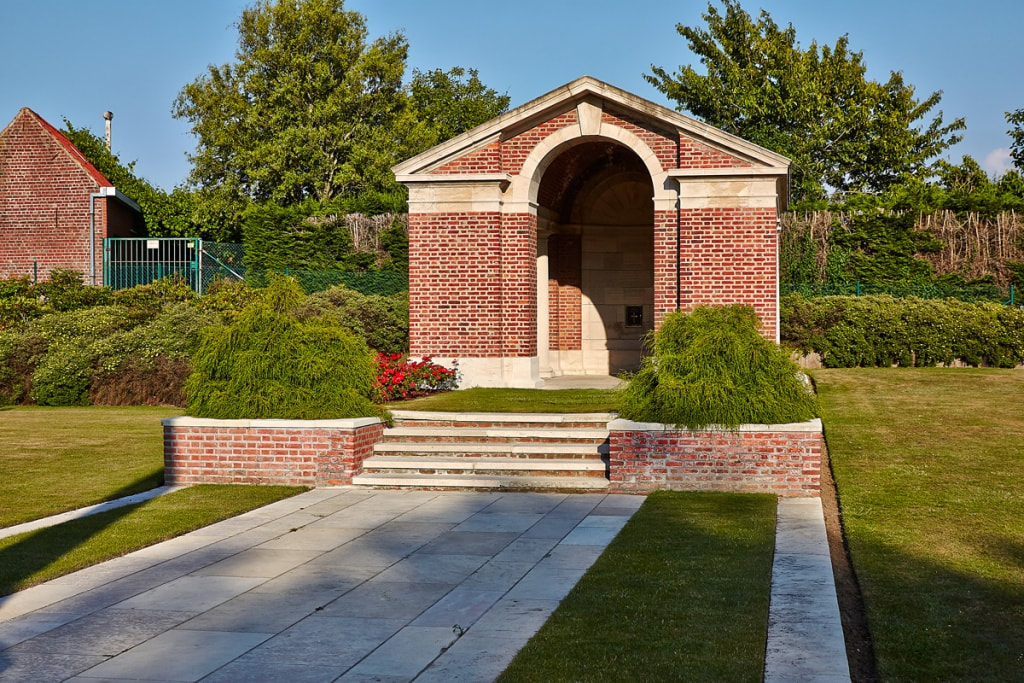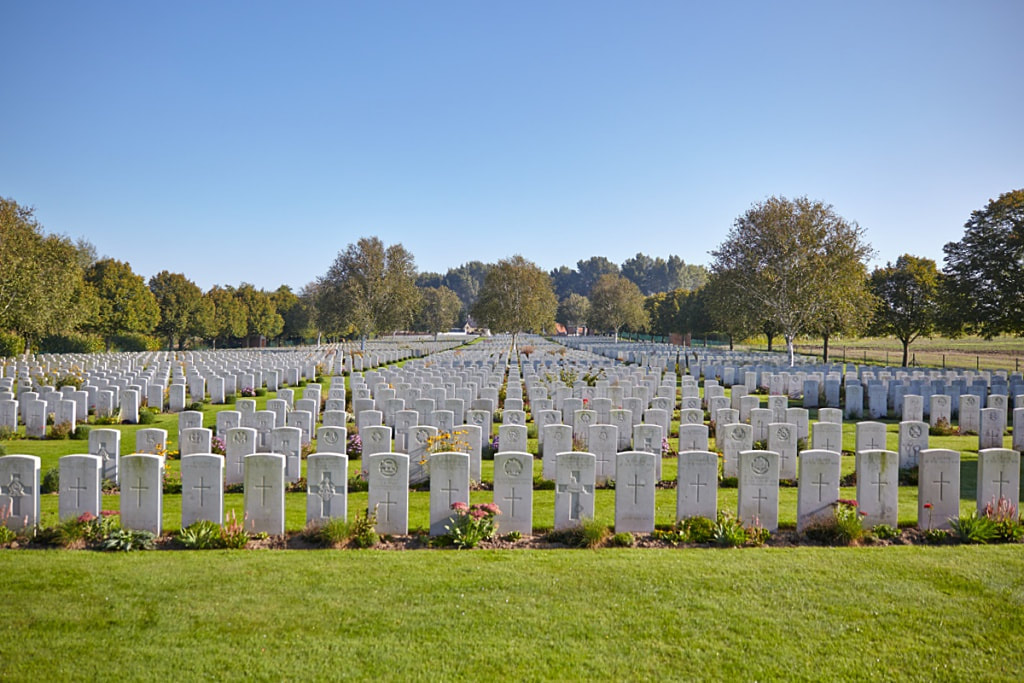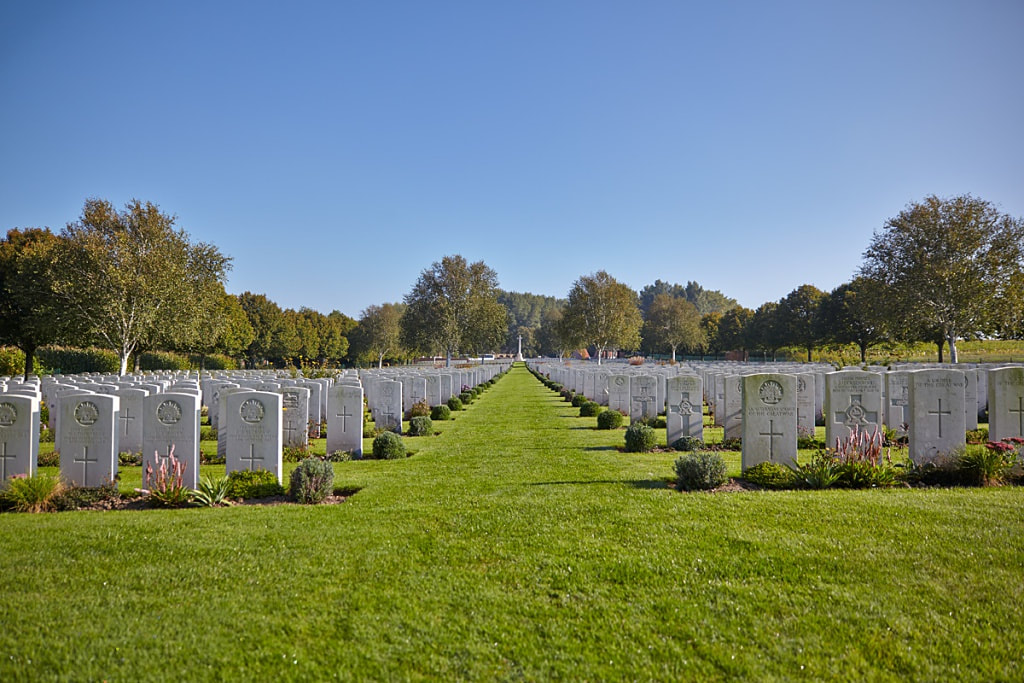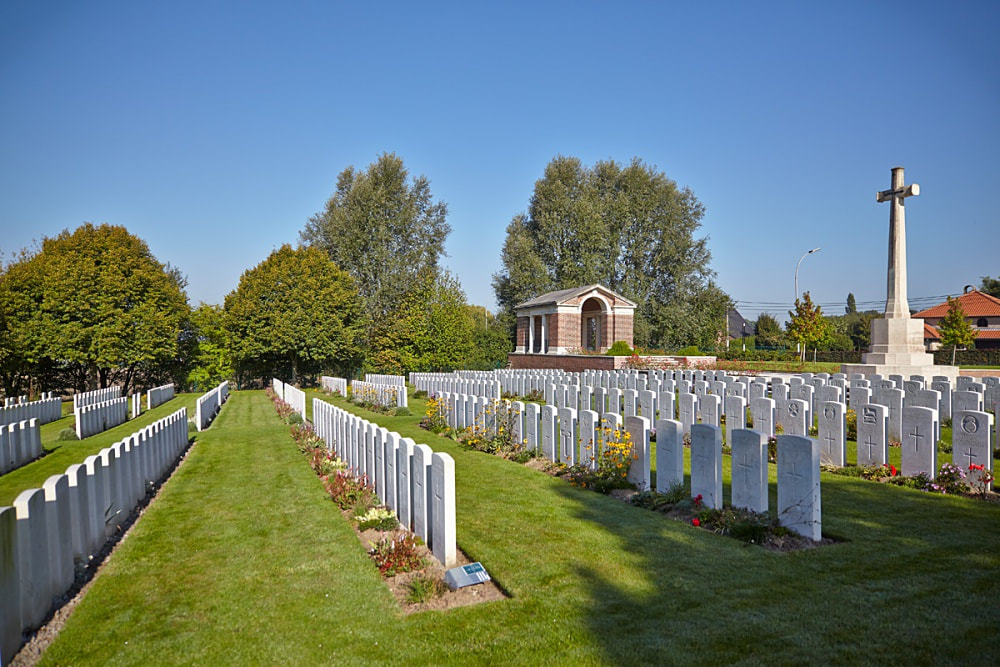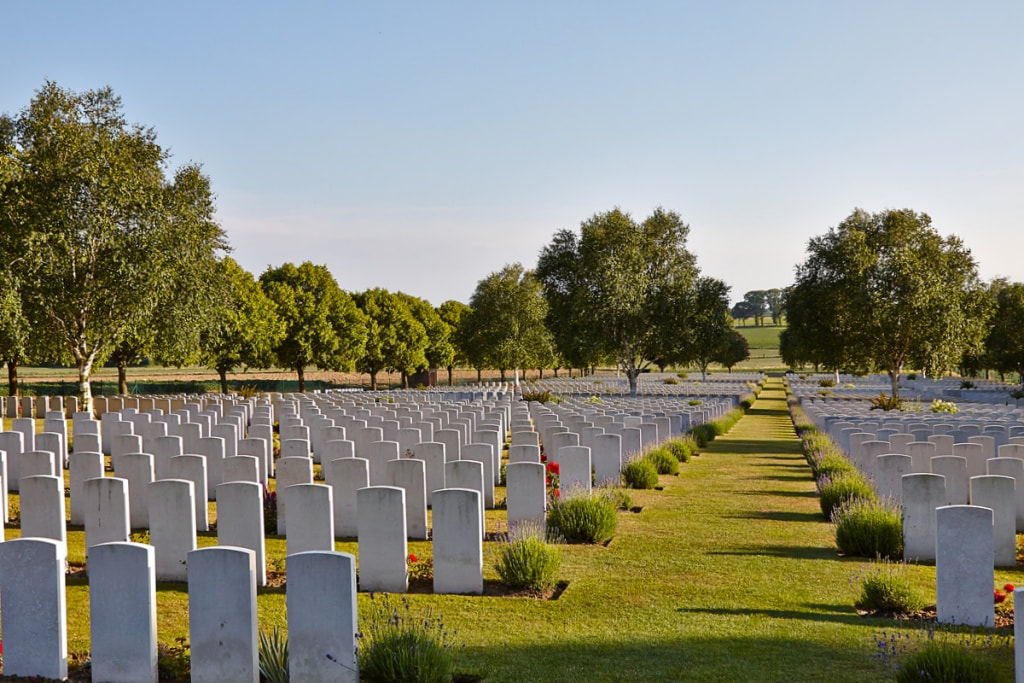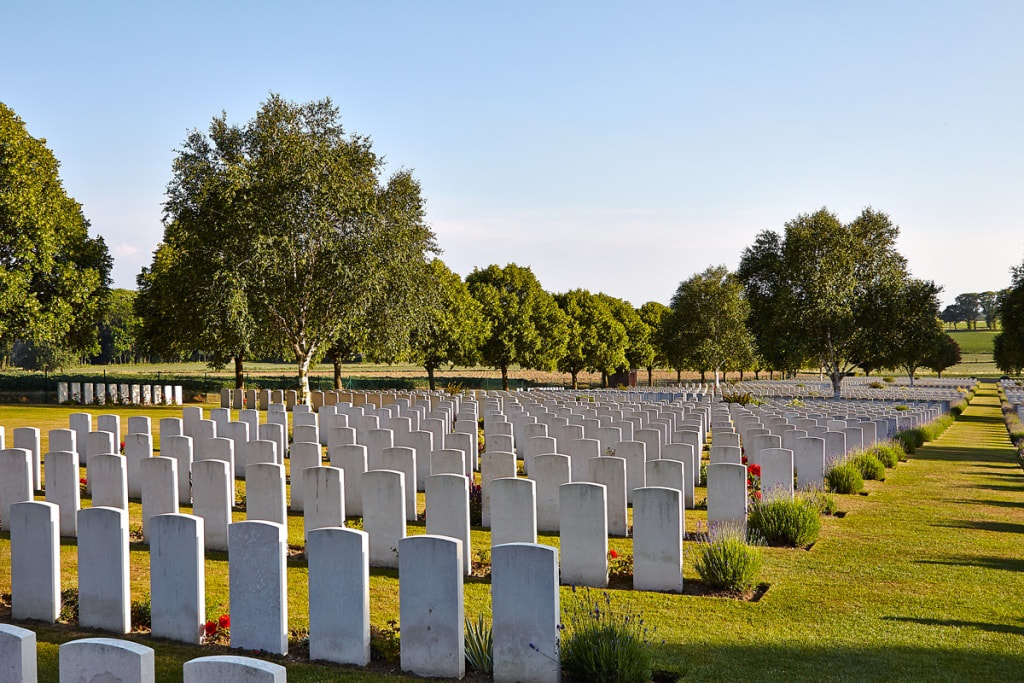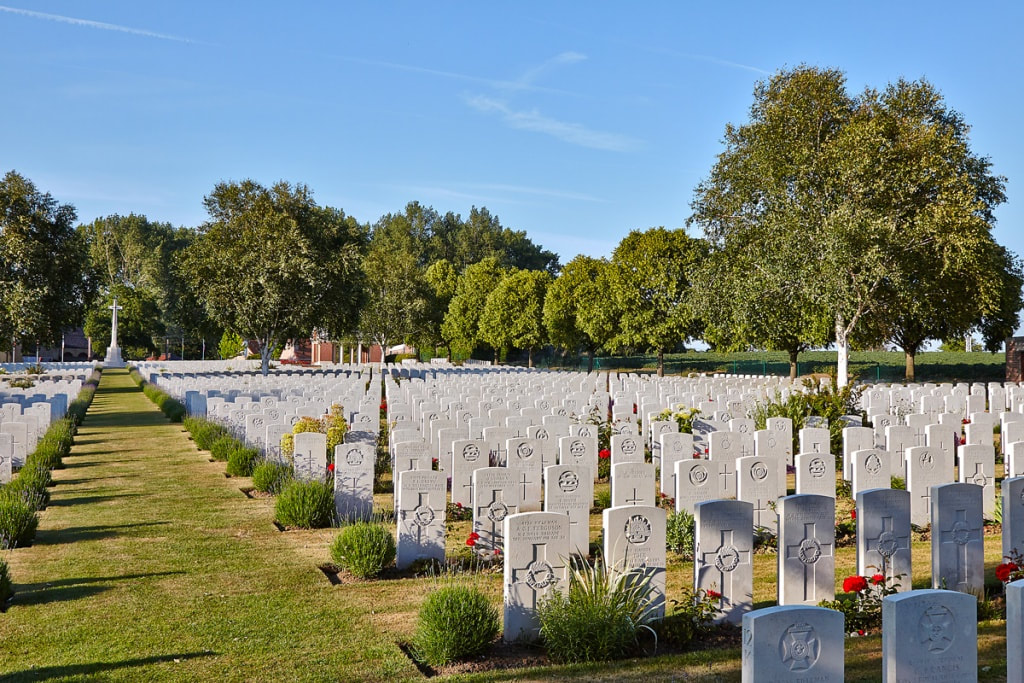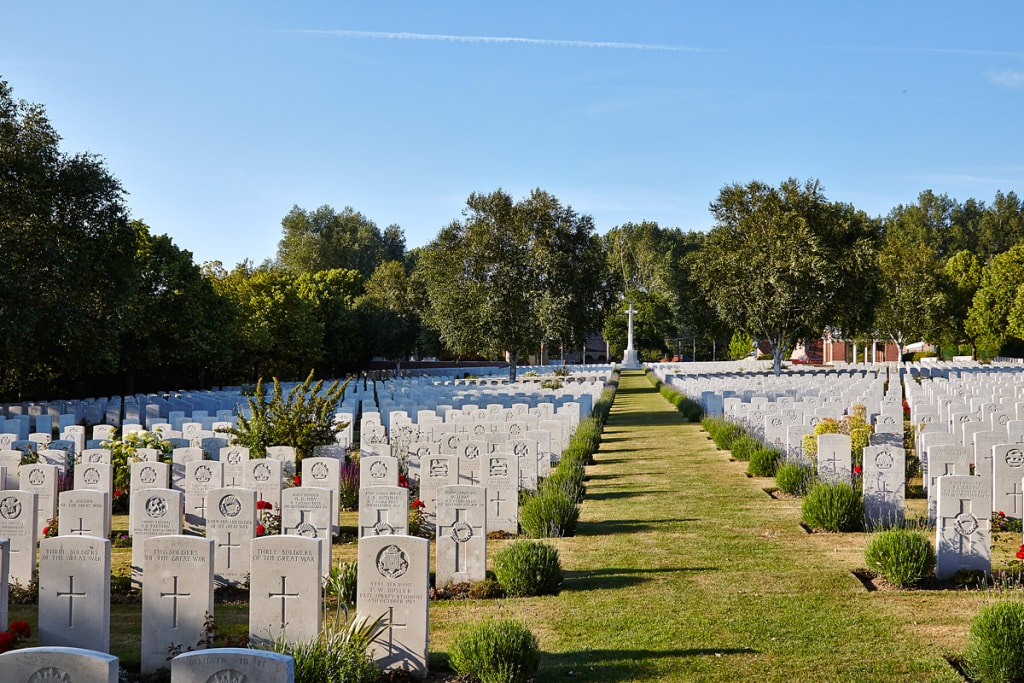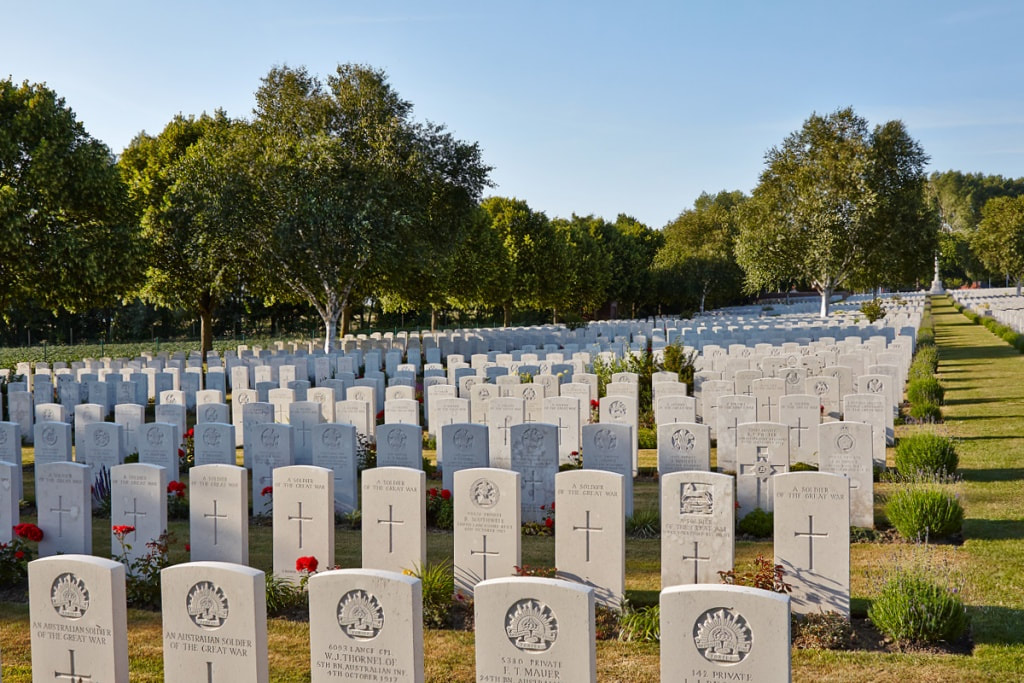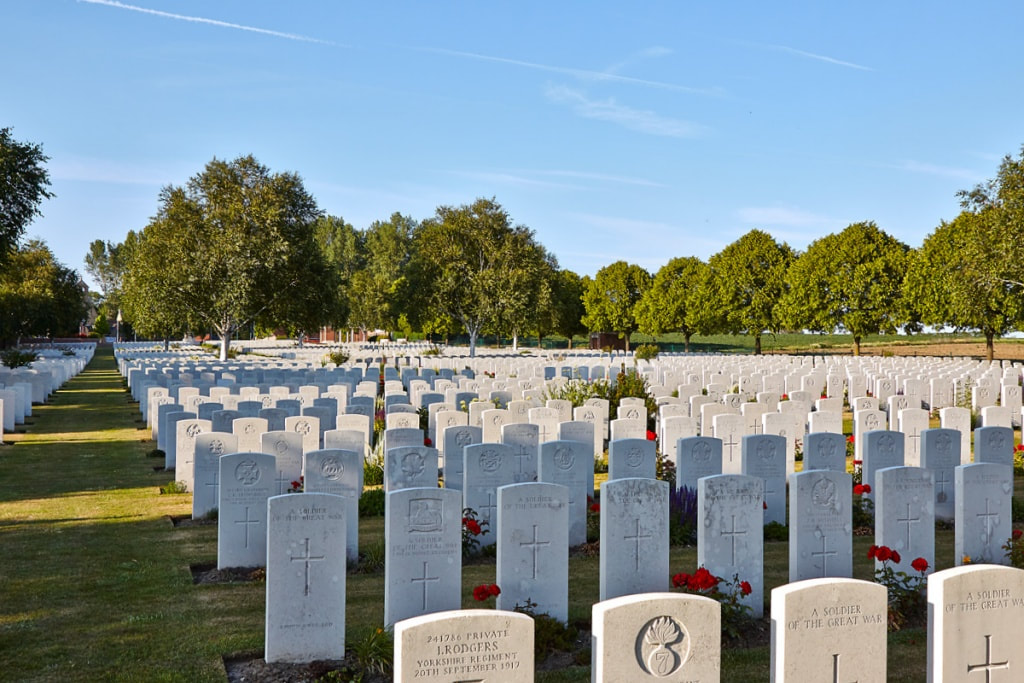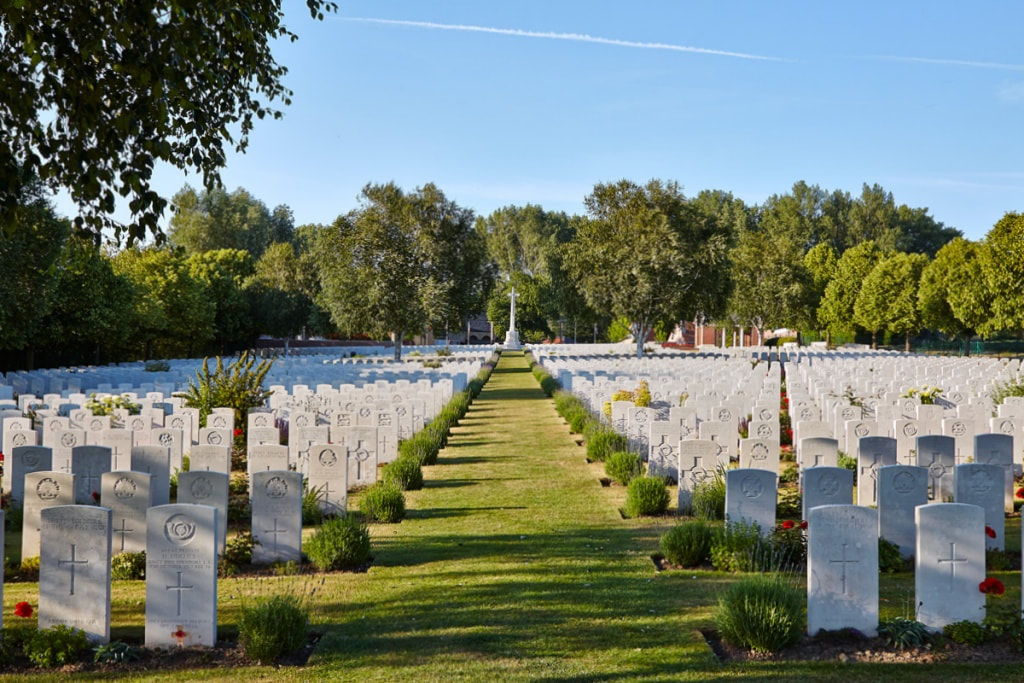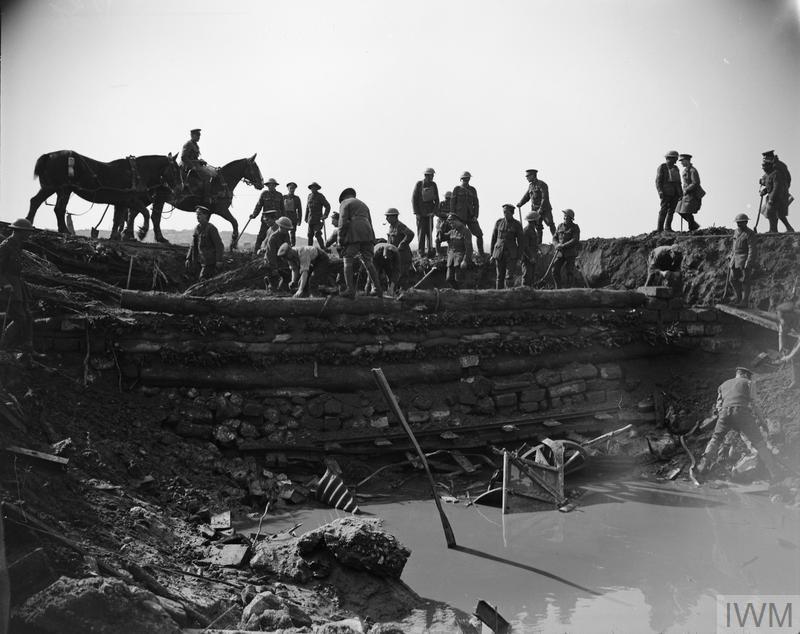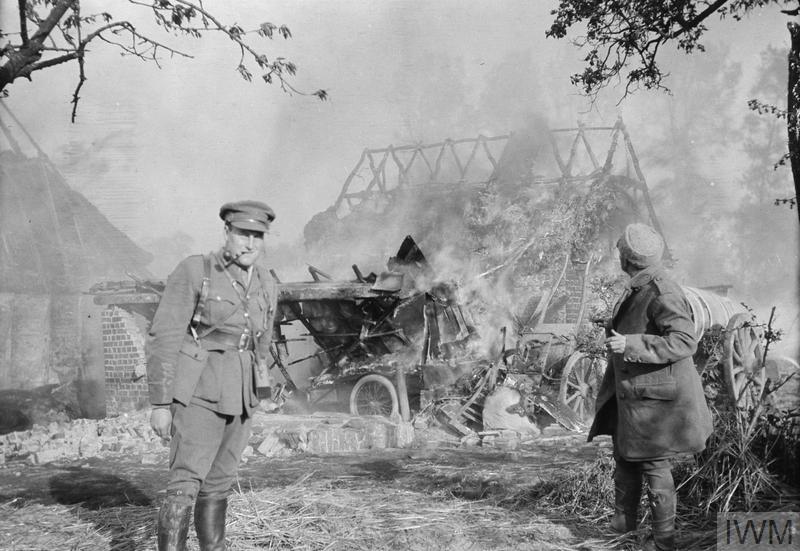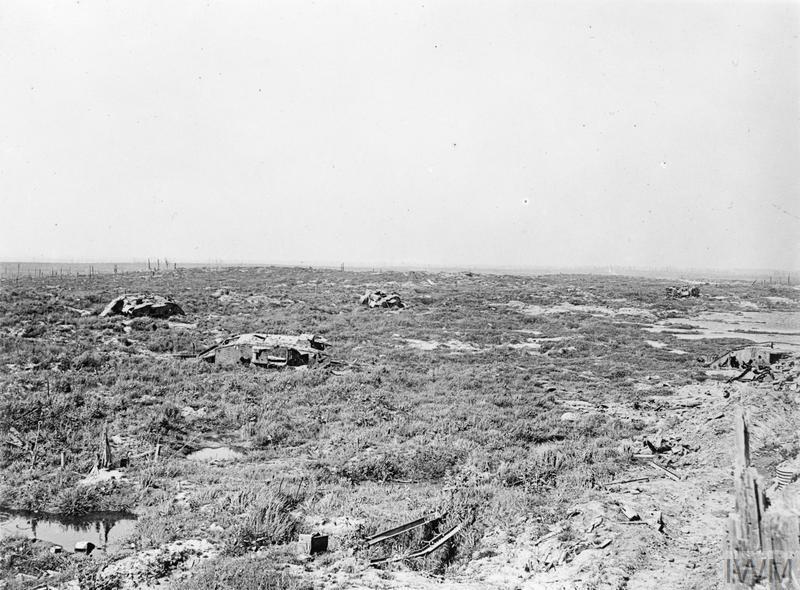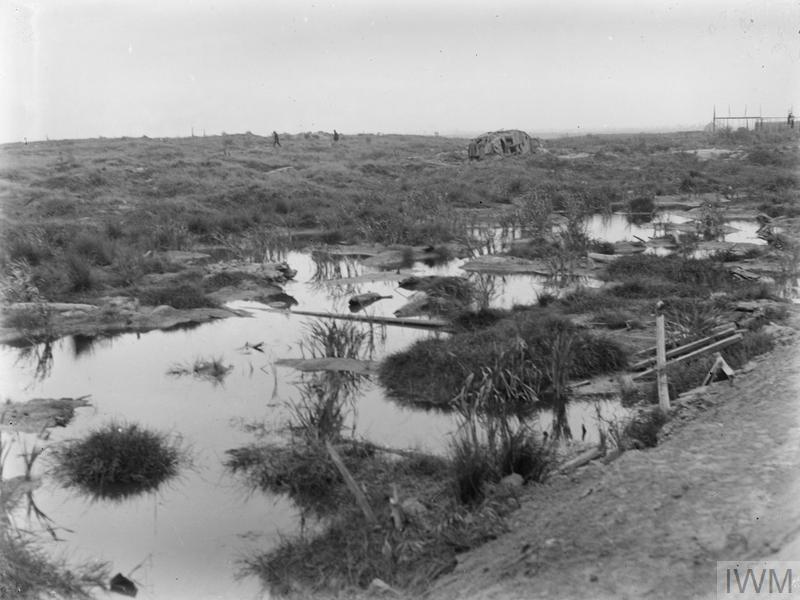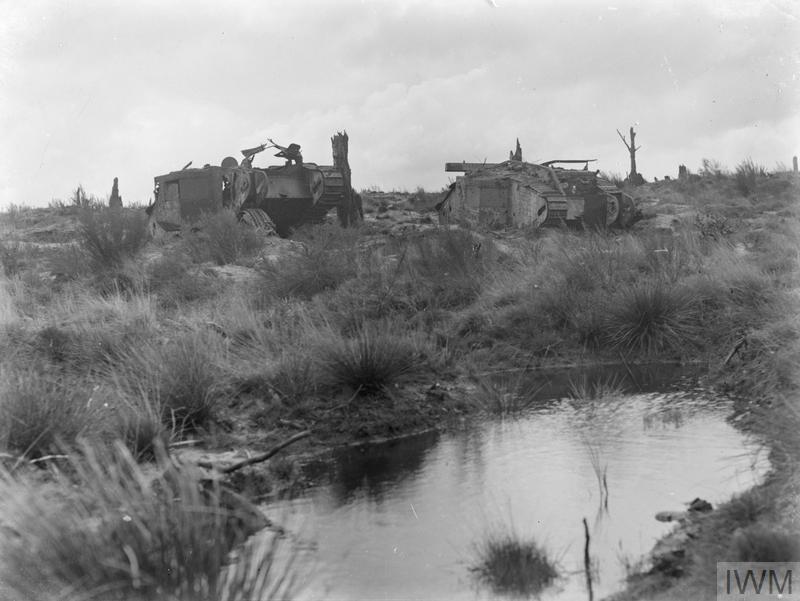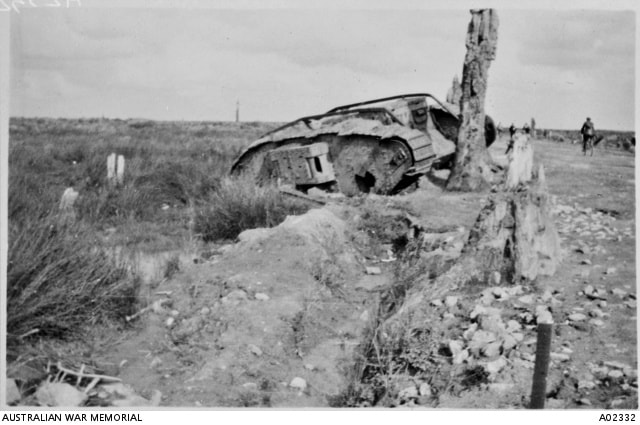HOOGE CRATER CEMETERY
West-Vlaanderen
Belgium
GPS Coordinates Latitude: 50.84623 Longitude: 2.9434
Roll of Honour
Location Information
Hooge Crater Cemetery is 4 Kms east of Ieper town centre on the Meenseweg (N8), connecting Ieper to Menen.
From Ieper town centre the Meenseweg is located via Torhoutstraat and right onto Basculestraat. Basculestraat ends at a main crossroads, directly over which begins the Meenseweg.
The cemetery itself is located 3.5 Kms along the Meenseweg on the right hand side of the road.
Wheelchair access to site possible, but may be by an alternative entrance.
Historical Information
Hooge Chateau and its stables were the scene of very fierce fighting throughout the First World War. On 31 October 1914, the staff of the 1st and 2nd Divisions were wiped out when the chateau was shelled; from 24 May to 3 June 1915, the chateau was defended against German attacks and in July 1915, the crater was made by a mine sprung by the 3rd Division. On 30 July, the Germans took the chateau, and on 9 August, it and the crater were regained by the 6th Division. The Germans retook Hooge on 6 June 1916 and on 31 July 1917, the 8th Division advanced 1.6 Kms beyond it. It was lost for the last time in April 1918, but regained by the 9th (Scottish) and 29th Divisions on 28 September.
Hooge Crater Cemetery was begun by the 7th Division Burial Officer early in October 1917. It contained originally 76 graves, in Rows A to D of Plot I, but was greatly increased after the Armistice when graves were brought in from the battlefields of Zillebeke, Zantvoorde and Gheluvelt and the following smaller cemeteries:-
BASS WOOD CEMETERIES No.1 and No.2, ZILLEBEKE, on the East side of the Bassevillebeek, 1 Km South of Herenthage Chateau. They contained the graves of 48 soldiers from the United Kingdom who fell in December, 1917-March, 1918.
KOELENBERG GERMAN CEMETERIES, GHELUWE, close together on the South side of the Menin Road, in which were buried ten soldiers from the United Kingdom.
K.O.S.B. CEMETERY, GHELUWE, on the Menin Road, 1 Km West of Gheluwe. Here were buried, after the capture of Gheluwe by the 34th Division, in October, 1918, 18 soldiers from the United Kingdom, of whom ten belonged to the 1st/5th K.O.S.B.
LA CHAPELLE FARM, ZILLEBEKE, between Chester Farm and Blauwepoort Farm, where 17 soldiers from the United Kingdom were buried in February and March, 1915.
MENIN ROAD PILLBOX CEMETERY, ZILLEBEKE, between Herenthage Chateau and Gheluvelt, where 20 soldiers from the United Kingdom were buried in October, 1917.
NIEUWE KRUISEECKE CABARET CEMETERY, GHELUVELT, on the South side of the Menin Road, where 21 soldiers from the United Kingdom and one from Canada were buried in October, 1918.
PILLBOX CEMETERY, ZONNEBEKE, 500 metres North-East of Westhoek, which was used in October, 1917; there were buried in it 34 soldiers from Australia, 26 from the United Kingdom, two from Canada and one of the British West Indies Regiment.
SANCTUARY WOOD OLD BRITISH CEMETERY, ZILLEBEKE, within the wood and North-East of the present cemetery; there were buried in it, in 1915-1917, 50 soldiers from the United Kingdom (of whom 30 were unidentified) and four from Canada.
TOWER HAMLETS CEMETERY, GHELUVELT, between Gheluvelt and Bass Wood, on the West side of a row of "pillboxes" called Tower Hamlets; it contained the graves of 36 soldiers from the United Kingdom who fell in the winter of 1917-1918.
WESTHOEK RIDGE SMALL CEMETERY, ZONNEBEKE, in Westhoek village, "near the Area Commandant's pillbox and the A.D.S."; it was used in the autumn of 1917, and it contained the graves of 16 soldiers from Australia and six from the United Kingdom.
There are now 5,916 Commonwealth servicemen of the First World War buried or commemorated in this cemetery. 3,568 of the burials are unidentified, but special memorials record the names of a number of casualties either known or believed to be buried among them, or whose graves in other cemeteries were destroyed by shell fire.
The cemetery was designed by Sir Edwin Lutyens and Noel Ackroyd Rew
Total Burials: 5,916.
Identified Casualties: United Kingdom 1,864, Australia 337, New Zealand 78, Canada 69. Total 2,348.
Unidentified Casualties: 3,568. Total 3,568.
Dedications
2nd Lieutenant George William Franklyn "C" Coy. 23rd Bn. London Regiment 7th June 1917, aged 32. Son of George William Franklyn of Hornchurch, Essex.
Remembered with honour by Matthew Abel
Hooge Crater Cemetery is 4 Kms east of Ieper town centre on the Meenseweg (N8), connecting Ieper to Menen.
From Ieper town centre the Meenseweg is located via Torhoutstraat and right onto Basculestraat. Basculestraat ends at a main crossroads, directly over which begins the Meenseweg.
The cemetery itself is located 3.5 Kms along the Meenseweg on the right hand side of the road.
Wheelchair access to site possible, but may be by an alternative entrance.
Historical Information
Hooge Chateau and its stables were the scene of very fierce fighting throughout the First World War. On 31 October 1914, the staff of the 1st and 2nd Divisions were wiped out when the chateau was shelled; from 24 May to 3 June 1915, the chateau was defended against German attacks and in July 1915, the crater was made by a mine sprung by the 3rd Division. On 30 July, the Germans took the chateau, and on 9 August, it and the crater were regained by the 6th Division. The Germans retook Hooge on 6 June 1916 and on 31 July 1917, the 8th Division advanced 1.6 Kms beyond it. It was lost for the last time in April 1918, but regained by the 9th (Scottish) and 29th Divisions on 28 September.
Hooge Crater Cemetery was begun by the 7th Division Burial Officer early in October 1917. It contained originally 76 graves, in Rows A to D of Plot I, but was greatly increased after the Armistice when graves were brought in from the battlefields of Zillebeke, Zantvoorde and Gheluvelt and the following smaller cemeteries:-
BASS WOOD CEMETERIES No.1 and No.2, ZILLEBEKE, on the East side of the Bassevillebeek, 1 Km South of Herenthage Chateau. They contained the graves of 48 soldiers from the United Kingdom who fell in December, 1917-March, 1918.
KOELENBERG GERMAN CEMETERIES, GHELUWE, close together on the South side of the Menin Road, in which were buried ten soldiers from the United Kingdom.
K.O.S.B. CEMETERY, GHELUWE, on the Menin Road, 1 Km West of Gheluwe. Here were buried, after the capture of Gheluwe by the 34th Division, in October, 1918, 18 soldiers from the United Kingdom, of whom ten belonged to the 1st/5th K.O.S.B.
LA CHAPELLE FARM, ZILLEBEKE, between Chester Farm and Blauwepoort Farm, where 17 soldiers from the United Kingdom were buried in February and March, 1915.
MENIN ROAD PILLBOX CEMETERY, ZILLEBEKE, between Herenthage Chateau and Gheluvelt, where 20 soldiers from the United Kingdom were buried in October, 1917.
NIEUWE KRUISEECKE CABARET CEMETERY, GHELUVELT, on the South side of the Menin Road, where 21 soldiers from the United Kingdom and one from Canada were buried in October, 1918.
PILLBOX CEMETERY, ZONNEBEKE, 500 metres North-East of Westhoek, which was used in October, 1917; there were buried in it 34 soldiers from Australia, 26 from the United Kingdom, two from Canada and one of the British West Indies Regiment.
SANCTUARY WOOD OLD BRITISH CEMETERY, ZILLEBEKE, within the wood and North-East of the present cemetery; there were buried in it, in 1915-1917, 50 soldiers from the United Kingdom (of whom 30 were unidentified) and four from Canada.
TOWER HAMLETS CEMETERY, GHELUVELT, between Gheluvelt and Bass Wood, on the West side of a row of "pillboxes" called Tower Hamlets; it contained the graves of 36 soldiers from the United Kingdom who fell in the winter of 1917-1918.
WESTHOEK RIDGE SMALL CEMETERY, ZONNEBEKE, in Westhoek village, "near the Area Commandant's pillbox and the A.D.S."; it was used in the autumn of 1917, and it contained the graves of 16 soldiers from Australia and six from the United Kingdom.
There are now 5,916 Commonwealth servicemen of the First World War buried or commemorated in this cemetery. 3,568 of the burials are unidentified, but special memorials record the names of a number of casualties either known or believed to be buried among them, or whose graves in other cemeteries were destroyed by shell fire.
The cemetery was designed by Sir Edwin Lutyens and Noel Ackroyd Rew
Total Burials: 5,916.
Identified Casualties: United Kingdom 1,864, Australia 337, New Zealand 78, Canada 69. Total 2,348.
Unidentified Casualties: 3,568. Total 3,568.
Dedications
2nd Lieutenant George William Franklyn "C" Coy. 23rd Bn. London Regiment 7th June 1917, aged 32. Son of George William Franklyn of Hornchurch, Essex.
Remembered with honour by Matthew Abel
3774 Private Patrick Bugden, V. C.
31st Bn. Australian Infantry Force.
He was killed in action on 28th September 1917, aged 20.
Plot VIII. C. 5.
Son of Thomas and Annie Bugden, of "Hotel Wells," Tweed Heads, New South Wales. Born at Gundurimba, New South Wales.
His headstone bears the inscription; "Thy Will Be Done Not Mine."
Studio portrait of 3774 Private (Pte) Patrick Joseph Bugden VC, 31st Battalion. A hotel keeper from Alstonville, New South Wales, prior to enlistment on 25 May 1916 he embarked from Brisbane aboard the HMAT Seang Choon on 19 September 1916 for Plymouth, England, before joining his battalion on the Western Front, France, on 19 March 1917. Pte Bugden was killed in action at Polygon Wood, Belgium, on 28 September 1917. He was aged 20 years. Pte Bugden was posthumously awarded the Victoria Cross.
Citation
An extract from "The London Gazette," No. 30400, dated 26th Nov., 1917, records the following:-"For most conspicuous bravery and devotion to duty when on two occasions our advance was temporarily held up by strongly defended "pill-boxes". Pte. Bugden, in the face of devastating fire from machine guns, gallantly led small parties to attack these strong points and, successfully silencing the machine guns with bombs, captured the garrison at the point of the bayonet. On another occasion, when a Corporal, who had become detached from his company, had been captured and was being taken to the rear by the enemy, Pte. Bugden, single-handed, rushed to the rescue of his comrade, shot one enemy and bayoneted the remaining two, thus releasing the Corporal. On five occasions he rescued wounded men under intense shell and machine gun fire, showing an utter contempt and disregard for danger. Always foremost in volunteering for any dangerous mission, it was during the execution of one of these missions that this gallant soldier was killed."
Headstone
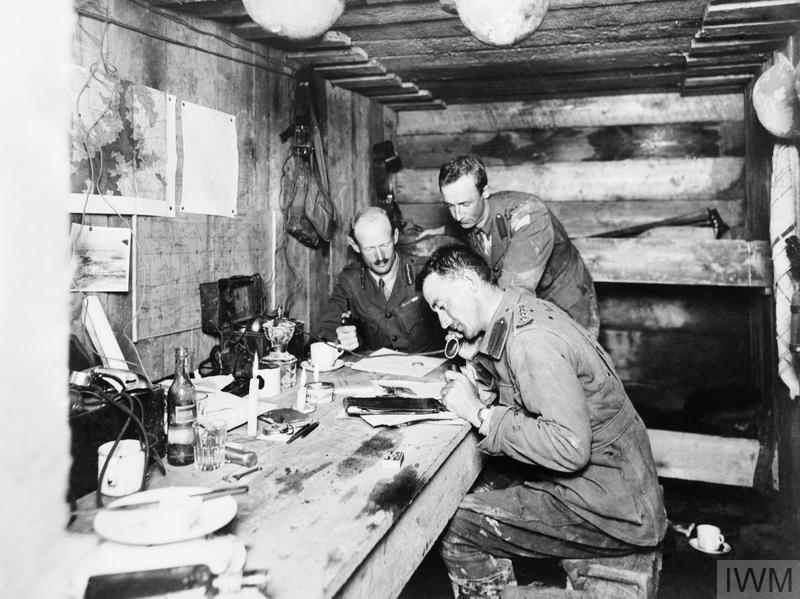
20th September 1917; Battle of Menin Road: Brigadier H G Bennett of the Australian Imperial Force conducting operations with two assistants in his battle headquarters at Hooge Crater during the battle for the Menin Road. Note the steel helmets hanging from the ceiling to catch the continuous drips from the wet Flemish clay. © IWM E(AUS) 710
Images in this gallery © Werner Van Caneghem
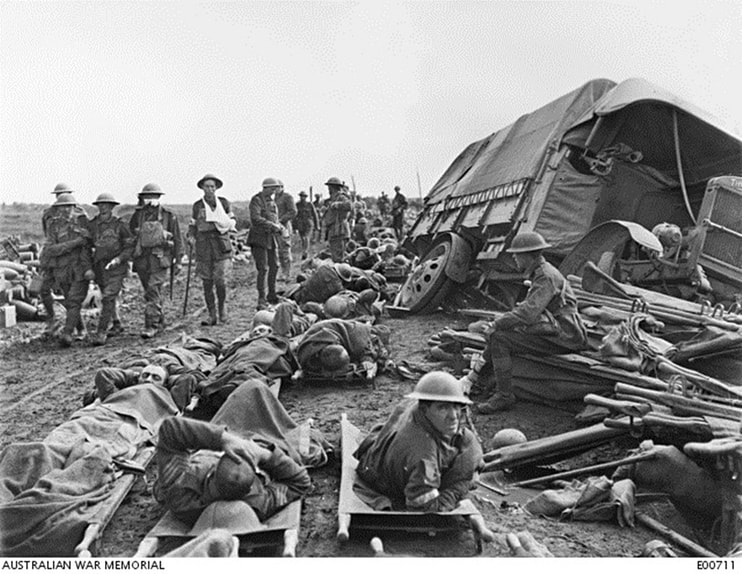
A scene on the Menin Road near Hooge, looking towards Birr Cross Roads, during the battle on 20 September 1917. The wounded on the stretchers are waiting to be taken to the clearing stations; others able to walk are making their way along the road as far as possible. Identified are: Major (Maj) G A M Heydon MC, Regimental Medical Officer of the 8th Battalion (fifth from the left with his arm in a sling). To his left is Private W Bain and next to him is Private (Pte) 'Spud' Murphy. To Pte Murphy's left (wearing a pack) is 58 Lance Corporal (LCpl) Roy Arthur Findlay MM, all are members of the 1st Field Ambulance. Shortly after the photograph was taken a shell landed in approximately the area where Maj Heydon and Pte Murphy had been standing. The shell killed most of the wounded on stretchers and LCpl Findlay was blown under the truck, shown lying on its side to the right.

This sign was collected by 1689 Sergeant Walter Ernest Brown VC, DCM, 5917 Private William Horatio Thomas Henry Wise and 54453 Private Bailey Horace Kent, all of the 20th Battalion for a proposed 20 Battalion museum. Instead the sign was donated by them in March 1919 to the Australian War Records Section for the National Museum being developed. Hooge and the Birr X roads (also known as Birr Cross Roads) are located to the east of Ypres and north east of Zillebeke in Belgium. In 1917, the 20th Battalion fought near Ypres in the Battle of Menin Road in September 1917. From Westhoek Ridge they attacked Hannabeek (Hanabeek) Wood, north east of Westhoek, capturing and holding their objective against two counter attacks. They were relieved by the 19th Battalion on the night of 21 September.


